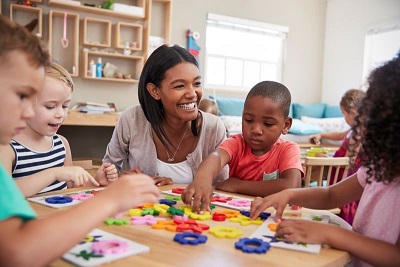Teacher TIPS: Licensing Compliance in Safe Sleeping and Resting
Licensing Compliance for Safe Sleeping and Resting

Sleep, baby, sleep. Thy father’s watching the sheep. Thy mother’s shaking the dreamland tree, and down drops a little dream for thee. ~ Elizabeth Prentiss
Naptime and the time around it can be a hectic time for both teachers and children if routines are not established and safety guidelines not met. Setting the environment for sleep takes patience and an understanding that while we as adults would love to rest mid-day, many children fight this down time. Help your children by being consistent with calming activities and transitions to help them rest their brains and bodies for an afternoon of fun.
Following are some line items from the CCLC Rules and Regulations, with tips or reminders in bold italics:
591-1-1-.30 Safe Sleeping and Resting Requirements
(1) Sleeping and Resting Equipment.
(a) Cribs. A crib that is safety approved in compliance with Consumer Product Safety Commission (CPSC) and American Society of Testing and Materials International (ASTM) safety standards shall be provided for each infant. ("Infant" refers to any child under the age of twelve (12) months or any child who is under eighteen (18) months of age who is not walking.) Keep your crib papers somewhere to reference in case of a recall or update.
- Crib Construction. Cribs shall be in good repair and free of hazards. Stack cribs and cribs with drop sides shall not be used. Periodically inspect the cribs for cracks, wear, or other safety issues.
- Crib Mattress. A mattress shall be provided for each crib and shall be firm, tight-fitting without gaps, at least two inches (2") thick and covered with waterproof, washable material. Before a change of occupant, each mattress shall be cleaned with a disinfectant. Inspect the mattresses daily and replace when torn or worn.
- Crib Sheet. Each crib shall have only an individual, tight-fitting sheet which is changed daily or more often as needed and prior to a change of occupant. A loose-fit can cause unsafe sleep conditions.
(b) Cots and Mats. Cots and mats shall be provided for each child who is two (2) years of age or older and who is required to take a nap and for each child under the age of two (2) years who can climb out of a crib.
- Cot and Mat Construction. Cots and mats shall be of sound construction and of sufficient size to accommodate comfortably the size and weight of the child. Mats must be in good repair,
washable, covered with waterproof material and at least two inches (2") thick. Inspect cots or mats for wear and tear that can lead to unsanitary or unsafe equipment.
- Individual Use. Cots and mats must be used by the same child daily and marked for individual
use. Posting a list of marked cots/mats and their user in the storage area allows for consistency in this rule.
- Sheets. Sheets or similar coverings for cots or mats shall either be marked for individual use or laundered daily. If marked for individual use, they must be laundered weekly or more frequently if needed. Some schools put the sheets back into the child’s cubby at the end of nap to keep them separated.
- Covers. A light cover shall be available for each child's use on a cot or mat and shall be marked for individual use or laundered daily. If marked for individual use, they must be laundered weekly or more frequently if needed. Give parents specific styles or sizes of covers to use, so that the cover is not cumbersome in storage.
(c) Pillows. Pillows shall not be used by children under two (2) years of age. When used for children two (2) years of age or older, pillows shall be assigned for individual use and covered with pillow cases that are marked for individual use or covered with cases that are laundered daily. Pillow cases that are marked for individual use shall be laundered weekly or more frequently as needed. If pillows are used, again give parents the style and size preferred for storage purposes.
(d) Arrangement of Sleeping and Resting Equipment. All sleeping and resting equipment shall be
arranged to avoid obstructing access to exit doors, to provide the caregivers access to each child, and to prevent children's access to cords hanging from window treatments and other hazardous objects. To reduce the transfer of airborne diseases, sleeping and resting equipment shall be arranged as follows.
There shall be a minimum of twenty-four inch (24") corridor between each row of sleeping or resting equipment. There shall be a minimum of twelve inches (12") between each piece of sleeping or resting equipment in each row of equipment. Children shall be placed on cots and mats so that one child's head is toward another child's feet in the same row. Using the same spaces for cots/mats gives the children consistency daily to help them get into a routine to settle down.
(2) Sleeping and Resting Environment for Infants. A Center shall provide a safe sleep environment in accordance with American Academy of Pediatrics (AAP), Consumer Product Safety Commission (CPSC) and American Society for Testing and Materials (ASTM) recommendations as listed in these rules for all infants. Center Staff shall place an infant to sleep on the infant's back unless the Parent has provided a physician's written statement authorizing another sleep position for that particular infant that includes how the infant shall be placed to sleep and a time frame that the instructions are to be followed. When an infant can easily turn over from back to front and back again, Staff shall continue to put the infant to sleep initially on the infant's back but allow the infant to roll over into his or her preferred position and not re-position the infant. Sleepers, sleep sacks and wearable blankets that fit according to the commercial manufacturer's guidelines and will not slide up around the infant's face may be used when necessary for the comfort of the sleeping infant, however swaddling shall not be used unless the Center has been provided a physician's written statement authorizing its use for a particular infant that includes instructions and a time frame for swaddling the infant. Staff shall not place objects or allow objects to be placed in or on the crib with an infant such as but not limited to toys, pillows, quilts, comforters, bumper pads, sheepskins, stuffed toys, or other soft items and shall not attach objects or allow objects to be attached to a crib with a sleeping infant such as but not limited to crib gyms, toys, mirrors and mobiles. Parents WILL attempt to have you attempt sleep positions that violate this rule, because they find their child sleeps better at home with positions or items that you CANNOT allow in your classroom. Help them understand that you CANNOT place their child on their stomach, prop their child’s mattress, let their child sleep in the swing, or sleep with a soft toy or blanket for their own safety. If you need help getting this extremely important message across to a parent, let your management team help you have that conversation with the parent. Children have died when these rules have not been followed-don’t let this happen to you!
(a) Center shall maintain the infant's sleeping area to be comfortable for a lightly clothed adult within a temperature range of sixty-five (65) to eighty-five (85) degrees depending upon the season. There shall be lighting adequate to see each sleeping infant's face to view the color of the infant's skin and check on the infant's breathing. Best practice is to establish a system to check on each sleeping infant at least every fifteen minutes.
(b) Wedges, other infant positioning devices and monitors shall not be used unless the Parent provides a physician's written statement authorizing its use that includes how to use the device and a time frame for using the device is provided for that particular infant. A parent’s insistence or written request is not acceptable here. A physician’s note must be specific, and it is good practice to share the note with your licensing consultant to verify it is specific enough.
(c) Infants shall not sleep in equipment other than safety-approved cribs, such as, but not limited to, a car safety seat, bouncy seat, highchair, or swing. Infants who arrive at the Center asleep or fall asleep in such equipment, on the floor or elsewhere, shall be transferred to a safety-approved crib. As you will have learned in SIDS prevention trainings, these devices position a sleeping child so that their airways can be obstructed and prevent proper breathing. Children do get accustomed to sleeping in a bare crib on their backs with consistency. Safe sleep is too important to jeopardize in these types of equipment.
(3) Night-time Care. For Centers that offer night-time care, each child, except infants who require individual cribs, shall be provided an individual bed with a four inch (4") mattress or a cot with a two inch (2") pad. Such equipment shall be arranged so that the children's sleep will not be unnecessarily interrupted by delivery and pick up of other children.
(4) Storage. If cots and mats are stored in the children's activity room or area, they shall be stored to prevent children's access to them and to allow maximum use of play space. When storage is available and used for the storage of cots and mats that allows the cots, mats and any bedding to be stored without touching any other cots, mats or bedding, the bedding may be left on the cot or mat. When such storage is not available for the cots and mats, each child's bedding shall be kept separate from other children's bedding and stored in containers marked for individual use, such as, but not limited to, bins, cubbies, or bags.
Establishing calm naptime routines is crucial to a peaceful naptime. Using books, relaxing music played at an appropriate level, and soft and low teacher voices helps children to get accustomed to this down time each day. Be sure to use only positive tones and conversations about and around the children, whether they are sleeping or not-venting or gossiping can disrupt their relaxation and the rest of their day!
